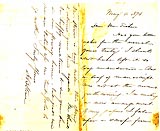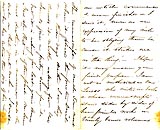

CLICK ANY PAGE TO ENLARGE  TRANSCRIPT |
According to Stowe, Uncle Tom's Cabin began with a
vision she had in church in early 1851, of a slave being beaten to death. The
manuscript of the novel was born when she got home from the service and
immediately began writing the vision down. According to family legend, she
quickly ran out of writing paper, and so "wrote a large part of it in pencil on
some brown paper in which groceries had been delivered."* Those pages are gone now, along with almost all the
hundreds of additional sheets of paper on which, over the course of a year's
composition, Stowe poured forth the story As she told an acquaintance in the letter you can read at left,
"The manuscript of Uncle Tom went where it pleased the printer's Devil & in
those days neither I or they deemed it worth asking for. Now I would give a
pretty sum for it." With the help of E. Bruce Kirkham's The Building of Uncle Tom's Cabin and the generous cooperation of one private collector and six special collections, we've tried to locate and bring together all the manuscript pages that have survived. Stowe herself always used religious terms to describe the creative process these pages allow us to access. At home that Sunday in February, 1851, transcribing the vision she'd had in church, it seemed "as if," she told her family, "what she wrote was blown through her mind as with the rushing of a mighty wind."* In her 1878 PREFACE, Stowe talked about the year she spent writing in similarly transcendent terms: the whole story, she said, was less "composed by her than imposed upon her." The surviving pages do have the look of being written quickly, but the lack of punctuation is typical of Stowe's manuscripts throughout her career. (As Howard Ticknor, one of Stowe's later publishers, put it: "she regarded spelling and punctuation as something quite outside the author's field, to be supplied by editor and printer."*) Kirkham's careful comparison of the surviving manuscript texts with the published magazine and novel texts led him to conclude that Stowe took more care and did more revising than most critics gave her credit for.* It is his belief that most if not all of the text went through three separate stages of manuscript: two before The National Era publication, and one more before Jewett's company printed the book near the end of the Era run. None of the mss. pages here are dated, but you can study them for yourself, and COMPARE them to the printed novel, by using the icons and links below. |

 Manuscripts Divison New York Public Library |
  C. W. Barrett Collection University of Virginia |

 Courtesy Mary Schlosser |
 The Story of Her Life |

 Connecticut State Library |

 Courtesy Mary Schlosser |
CLICK "COMPARE" TO SEE SIDE-BY-SIDE COMPARISONS, MS & PUBLISHED TEXT |
 |
 
|
 |
|
Radcliffe Institute |
Hartford, Connecticut |
||
